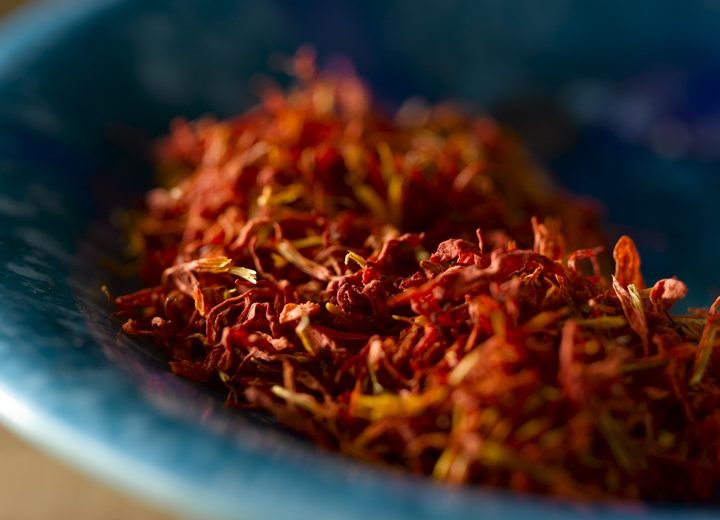
When I was a child, my mother (who was—and still is—a wonderful cook) had a small wooden spice rack with two rows of stoppered glass bottles. Those 16 little vials contained pretty much everything she needed, from ground cloves for Thanksgiving pumpkin pies to paprika she dusted on deviled eggs. Today, my mother’s spice collection fills a cupboard that’s four feet high and two feet deep. Ask her for the paprika, and she’ll ask you whether you want sweet, hot or smoked.
According to McCormick, which has been selling herbs and spices since 1889, today’s home cook is likely to keep at least 40 different seasonings on hand, whereas the typical 1950’s American homemaker relied on fewer than 10 spices. Although the three best-selling flavorings (black pepper, vanilla extract and cinnamon) haven’t changed since the end of World War II, the rest of the spice rack has undergone a dramatic transformation. McCormick’s sales figures indicate that allspice, lemon extract, ground mustard and celery seed— all top sellers in the postwar years—have slid in popularity, while oregano, cumin, coriander and smoked paprika have risen through the ranks.
Adventurous Cooks, Sophisticated Palates
Generations of immigrants have brought a rich array of culinary traditions from around the globe to North America—and today, these exotic cuisines are sought and celebrated like never before. Tanya Wenman Steel, editor-in-chief of the popular Epicurious website, sees users filling their online recipe boxes with Indian and Middle Eastern dishes in addition to the usual lasagna and chicken salad. A recent search for the most popular recipes on Epicurious tells the tale: South American arepas and Javanese chicken curry vie for top billing with chocolate fudge and apple tart.
“American cooks have gotten a lot more adventurous,” says food writer and cookbook editor Amanda Hesser, “but also more discerning. We not only use a wider range of spices, but we’ve gotten more sophisticated about layering different flavors to create more complex and intense flavor profiles.”
There’s also an increased value on authenticity. Instead of relying on cayenne pepper as an all-purpose source of heat, today’s cooks might use certain peppers for Asian cuisine and others for Latin dishes. “Chefs are traveling more widely—and not just to Europe—and bringing back exotic ingredients and techniques,” says Hesser. “And thanks to the speed of information sharing, an ingredient can make the leap from esoteric to household name in a much shorter period of time.”
Unusual spices are also getting easier to procure, with mainstream spice vendors vastly expanding their product lines in response to the growing popularity of global cuisines. These days, you might not have to go farther than the grocery store to find chipotle pepper or garam masala—seasonings that most of us didn’t even know how to pronounce just a few years ago. And with a few days’ lead time, you can get just about anything else you could possibly want from online vendors.
From Spice Cabinet to Medicine Cabinet
As ancient healers realized and modern science has confirmed, herbs and spices do much more than flavor our foods. They can also be concentrated sources of nutrients and compounds with medicinal effects. Virtually all herbs and spices display antimicrobial and antioxidant activity. Some of the most commonly used spices display other useful properties, as well. According to the Therapeutic Research Center’s Natural Medicines Comprehensive Database:
- Cinnamon has been shown to improve blood sugar control in diabetics in some studies although other studies showed no benefit.
- Garlic may slow the development of atherosclerosis and seems to be able to modestly reduce blood pressure. In addition, eating garlic has been linked to a decreased risk of developing stomach and colon cancers, although garlic supplements do not seem to offer this benefit.
- Ginger can help lessen nausea and vomiting in pregnant women and post-operative patients, and it may reduce symptoms of dizziness, including nausea. Also, there is preliminary evidence that ginger may have some benefits in managing osteoarthritis, specifically in reducing pain.
- Turmeric, a key ingredient in curry blends, has been shown to reduce symptoms of indigestion.
Making Food Safer with Spices
The preservative power of spices was also well understood by the ancients, who used spices to slow the spoilage of perishables and even to embalm their dead. Today, food scientists are increasingly interested in spices as a way to make our food supply safer, testing the ability of various herbs and extracts to kill E. coli bacteria in meat, for example. Although far from providing surefire protection from foodborne illness, garlic, clove and oregano are among the most promising candidates.
Even more encouraging is the ability of certain herbs and spices to reduce the formation of harmful compounds formed when meats are cooked at high temperatures, such as on a grill. According to a study in the October 2011 Journal of Food Science, adding rosemary or turmeric to a burger can reduce the formation of heterocyclic amines by up to 40 percent. A separate study published in the May 2010 American Journal of Clinical Nutrition found adding a mixture of ground cloves, cinnamon, oregano, ginger, rosemary, black pepper, paprika and garlic powder to burgers reduces the formation of carcinogenic and atherogenic compounds by 70 percent.
Storing and Using Spices
One possible downside to an ever-expanding repertoire of spices: Stocking dozens of different seasonings to fuel your culinary adventures increases the chances that spices will sit in the cupboard for a long time before you use them. Whenever possible, buy spices in amounts that you can use within 12 months. For unusual ingredients that you use rarely, look for a store that sells spices in bulk so that you can buy only as much as you need. And to keep herbs and spices at their peak of flavor and nutritional potency, that wooden rack next to the stove has got to go. Spices should be kept away from heat, moisture and light, and they are best stored in a cool, dark cupboard in airtight containers.



